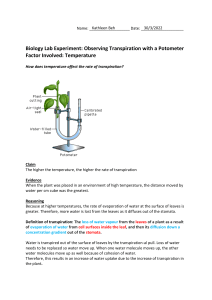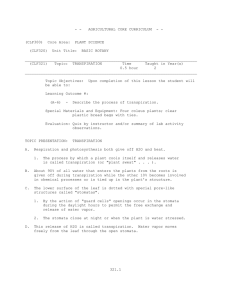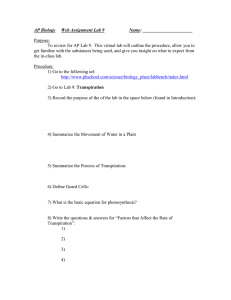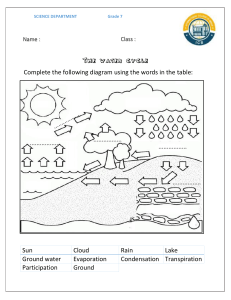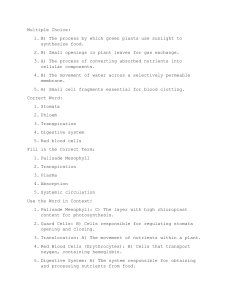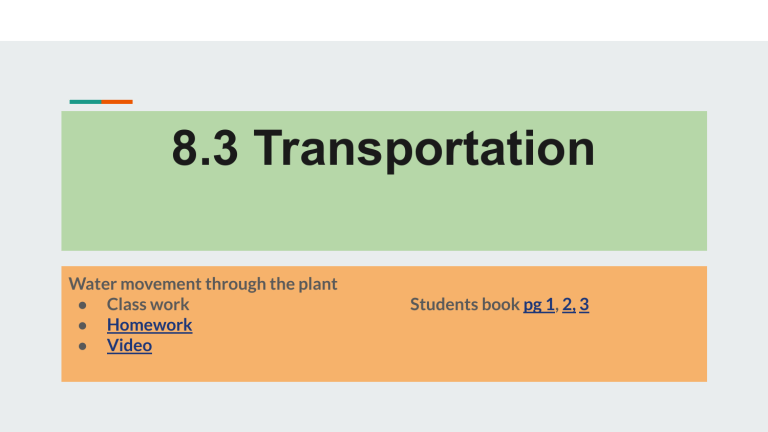
8.3 Transportation Water movement through the plant ● Class work ● Homework ● Video Students book pg 1, 2, 3 Learning Objective ● To recall that water movement through a plant begins with water loss from the leaves ● To understand that water is lost from leaves via the stomata, through which the exchange of gases between the leaf and the atmosphere also occurs ● To describe how the leaf surface most involved in water loss can be identified ● To understand how environmental conditions can affect water movement through plants Key term Wilting To wilt means to lose freshness or to become flaccid wilting occurs if water loss exceeds water uptake, the tissues become limp and the plant is no longer supported. Turgid swollen and distended or congested. Key term Transpiration: Transpiration is the process of water movement through a plant and its evaporation from aerial parts, such as leaves, stems and flowers. Active transport: Active Transport is defined as a process that involves the movement of molecules from a region of lower concentration to a region of higher concentration against a gradient or an obstacle with the use of external energy. TASK: Draw and label the diagram of Potometer Key term Transpiration stream: the transpiration stream is the uninterrupted stream of water and solutes which is taken up by the roots and transported via the xylem to the leaves. Potometer: A potometer' (from Greek Poto = drunken, and meter = measure), sometimes known as transpirometer, is a device used for measuring the rate of water uptake of a leafy shoot which is almost equal to the water lost through transpiration. Water uptake ● ● Transpiration is a side-effect of how leaves are adapted to maximise gas-exchange for photosynthesis Plants contain tiny pores (openings) called stomata that allow for gas exchange ○ Stomata are typically found on plant leaves but can be found on some stems Role of Stomata in transpiration ● ● ● ● ● Stomata are formed by two kidney-shaped guard cells which open and close the stomatal pore ○ Stomata can be opened or closed depending on the conditions the plant is in The role of stomata and guard cells is to control gas exchange and water loss Guard cells have cell walls with unevenly distributed cellulose – the inner wall is thicker and the outer wall is thinner to aid opening and closing of the stomata When the availability of water is high, guard cells become turgid as a result of osmosis ○ This causes the stomatal pore to open which allows gases to diffuse in and out of the leaf ○ Water is consequently lost via transpiration When less water is available, the guard cells lose water by osmosis and become flaccid, pulling them together Role of Stomata in transpiration Path of water movement to the leaf from the toots Atmospheric conditions may affect transpiration • Wind moves humid air away from the leaf surface and increases transpiration • High temperatures increase the water-holding capacity of the air and increase transpiration • Low humidity increases the water potential gradient betv.een leaf and atmosphere and increases transpiration • High light intensity causes stomata to open (to allow photosynthesis) which allows transpiration to occur Translocation ● ● ● The transport of the soluble products of photosynthesis (mainly sucrose) in the plant is called translocation ○ Translocation is an active process that requires energy Sucrose (and amino acids) are transported around the plant in the phloem tubes In general, translocation happens between where the substances are made (sources) and where they are used or stored (sinks). Plenary Past paper question - CW Reference Save my exam Cambridge biology students book by marry john

